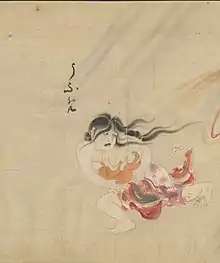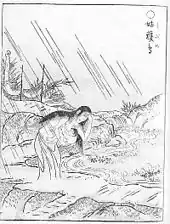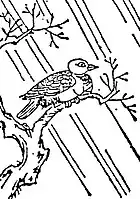Ubume
Ubume (Japanese: 産女) are Japanese yōkai of pregnant women.[1] They can also be written as 憂婦女鳥. Throughout folk stories and literature the identity and appearance of ubume varies. However, she is most commonly depicted as the spirit of a woman who has died during childbirth. Passersby will see her as a normal-looking woman carrying a baby. She will typically try to give the passerby her child then disappear.[2] When the person goes to look at the child in their arms, they discover it is only a bundle of leaves or large rock.[3] The idea that pregnant women who die and get buried become "ubume" has existed since ancient times; which is why it has been said that when a pregnant woman dies prepartum, one ought to cut the fetus out the abdomen and put it on the mother in a hug as they are buried. In some regions, if the fetus cannot be cut out, a doll would be put beside her.

Variations

In the 16th volume, first half of the Miscellaneous Morsels from Youyang of the Tang dynasty, volume 462 of the Taiping Guangji of Northern Song dynasty, the "night-going leisure woman" is a nocturnal strange bird that steals people's babies and about it is written, "perhaps it is the changed form of what was once someone who died in childbirth" (或言産死者所化). In Japan, they would often wear a blood-stained koshimaki, embrace children and chase after people who accompany them. They are also mentioned in the Hyakumonogatari Hyōban ("They are women who died upon childbirth, and became this due to attachment. In appearance, they are stained with blood below the waist, and they are said to cry out, "obareu, obareu" (をばれう)), the Kii Zōdan Shū ("the ubume does not give childbirth, and if only the fetus had life, such a deep delusion of the mother remains, and thus they change to this and embraces a child at night. It's said when the child cries, the ubume does too"), the Compendium of Materia Medica, and the Wakan Sansai Zue. The ubume's blood-soaked appearance is thought to be because in feudal society, the continuation of the family was considered important, so pregnant women who died were believed to fall into a hell with a pond of blood.[4]
Ubume in Hinoemata, Minamiaizu District and Kaneyama, Ōnuma District, Fukushima Prefecture were called "obo". It is said that when they encounter someone, they make that person hug a baby and then disappear in peace and the one hugging the baby will have their throat bitten by the baby. It is said that when one encounters an obo, throwing a piece of cloth, such as a string with a billhook attached for men, or a gōkōsō (a type of women's handkerchief), tenugui, or a yumaki (a type of waistcloth) for women, it would divert the obo's attention and create an opportunity to escape. It is also said that if one does end up hugging the baby, hugging the baby with its face facing the other way would result in not being bit.[5][6] Also, the "obo" is, like the "ubu" in "ubume", originally a dialect term referring to newborns.[5] In Yanaizu, Kawanuma District, there is a legend centered on the "obo" called the "obo hugging Kannon".
In the Nishimatsuura District, Saga Prefecture and in Miyamachi Miyaji, Aso, Kumamoto Prefecture, they are called "ugume" and it is said that they appear at night and they would make people embrace a baby a night, but when dawn comes, they would generally be a rock, a stone tower, or a straw beater.[7][8] (On Goshōra island in Nagasaki Prefecture, also in Kyushu, there is a type of funayūrei called "ugume".)
In the Iki region of Nagasaki Prefecture, they are called "unme" or "uume" and they occur when a young person dies or when a woman dies from difficult childbirth, and they would sway back and forth before disappearing, having the appearance of a creepy blue light.[9]

In Ibaraki Prefecture, there are legends of a yōkai called the "ubametori" and when children go dry their clothes a night, this ubametori would think of the child as their own, and give some poisonous milk. This has some similarities to a similar wrathful spirit called a kokakuchō and nowadays specialists infer that Ibaraki's ubametori is the same as this kokakuchō,[10] and furthermore, kokakuchō is theorized to be the changed form of a pregnant mother's spirit, so it is said that this mysterious bird is considered the same as ubume.[11] Also, the ubume in Japanese legends is a bird that resembles the gull in appearance and voice and it is said that they would land on the ground and shapeshift into a woman carrying a baby and they would request "please hold on to this child" to people they meet and those that flee would be cursed with chills and fevers and eventually death.[4] In Iwaki Province, now Fukushima Prefecture and Miyagi Prefecture, it is said that ryūtō (an atmospheric ghost light said to be lit by a dragon spirit) would appear at beaches and try to come up to land, but it is said that this is because an ubume is carrying a ryūtō to the shore.[12] In Kitaazumi District, Nagano Prefecture, ubume are called yagomedori, and they are said to stop at clothes drying at night, and it is said that putting on those clothes would result in dying before one's husband.[13]
Social and cultural influence
The yokai ubume was conceived through various means of social and religious influence. During the late Medieval period of Japan, the attitudes surrounding motherhood started to change. Rather than the infant being considered a replication of the mother and an extension of her body, the fetus started to be seen as separate from the mother. This distancing of mother and fetus caused an emphasis on the paternal ownership of the child, reducing the mother to nothing more than a vessel for male reproduction. For a mother to die in childbirth or late pregnancy soon came to be considered a sin, the blame for the death of the unborn child being placed on the mother who in a sense was responsible for the infant's death (Stone & Walter p. 176).
In folklore
Originally the name for a kind of small sea fish,[14] in Japanese folklore the term is now applied to the ghost of a woman who had died in childbirth, or "birthing woman ghost".[15][16]
Typically, the ubume asks a passerby to hold her child for just a moment and disappears when her victim takes the swaddled baby.[2] The baby then becomes increasingly heavy until it is impossible to hold. It is then revealed not to be a human child at all, but a boulder or a stone image of Jizō.[3]
Many scholars have associated the ubume with the legend of the hitobashira,[17] where a sacrificial mother and child "are buried under one of the supporting pillars of a new bridge."[16]
The Shoshin'in Temple, according to scholars,[3] is where local women come to pray to conceive a child or to have a successful pregnancy.[17] According to Stone and Walter (2008), the origins of the temple's legend, set in the mid-16th century, concern:
- a modern statue of Ubume, displayed once a year in July. At this festival, candy that has been offered to the image is distributed, and women pray for safe delivery and for abundant milk. The statue, which is clothed in white robes, has only a head, torso, and arms; it has no lower half.[18]
In literature
Stories about ubume have been told in Japan since at least the 12th century.[17]
The early 17th-century tale collection Konjaku hyaku monogatari hyoban says of the ubume:
- When a woman loses her life in childbirth, her spiritual attachment (shūjaku) itself becomes this ghost. In form, it is soaked in blood from the waist down and wanders about crying, ‘Be born! Be born!’ (obareu, obareu).[18]
Natsuhiko Kyogoku's best-selling detective novel, The Summer of the Ubume, uses the ubume legend as its central motif, creating something of an ubume 'craze'[19] at the time of its publication and was made into a major motion picture in 2005.[19]
In art
Tokugawa-era artists[15] produced many images of ubume, usually represented as "naked from the waist up, wearing a red skirt and carrying a small baby."[15]
Other illustrations of ubume are from Toriyama Sekien’s late-18th-century encyclopedia of ghosts, goblins, and ghouls, Gazu Hyakki Yagyō.[18]
See also
- Harpy
- Konaki-jiji, a childlike yōkai that, like the ubume's bundled 'infant', grows heavier when carried and ultimately takes the form of a boulder.
- Myling, an example of a similar motif in Scandinavian folklore.
- Pontianak
- Sankai, yōkai that emerge from pregnant women
Notes
- Bush (2001), p. 188
- Stone & Walter (2008), p. 191
- Joly (1908), p. 15
- 京極夏彦・多田克己編著 (2000). 妖怪図巻. 国書刊行会. pp. 151–152頁. ISBN 978-4-336-04187-6.
- 村上健司編著 (2005). 日本妖怪大事典. Kwai books. 角川書店. pp. 74–75頁. ISBN 978-4-04-883926-6.
- 中央大学 民俗研究会. "常民 26号 福島県大沼郡金山町 調査報告書". 怪異・妖怪伝承データベース. 国際日本文化研究センター. Retrieved 2008-12-08.
- 千葉幹夫 (1991). 妖怪お化け雑学事典. 講談社. pp. 69–70頁. ISBN 978-4-06-205172-9.
- "阿蘇デジタル博物館民間伝承". あそバーチャル体験ランド. 阿蘇テレワークセンター. Retrieved 2008-12-08.
{{cite web}}: External link in|work= - 日本妖怪大事典. pp. 42頁.
- 日本妖怪大事典. pp. 46–47頁.
- 京極夏彦文・多田克己編 (2008). 妖怪画本 狂歌百物語. 国書刊行会. pp. 275–276頁. ISBN 978-4-3360-5055-7.
- 人文社編集部 (2005). 諸国怪談奇談集成 江戸諸国百物語 東日本編. ものしりシリーズ. 人文社. pp. 20頁. ISBN 978-4-7959-1955-6.
- 志村有弘監修 (2008). 図説 地図とあらすじで読む 日本の妖怪伝説. 青春出版社. pp. 77頁. ISBN 978-4-413-00965-2.
- Hepburn (1887), p. 705
- Joly (1908), p. 16
- Stone & Walter (2008), p. 204
- Glassman (2001), p. 560
- Stone & Walter (2008), p. 192
- Foster (2009), p. 230
References
- Bush, Laurence C. (2001). Asian horror encyclopedia: Asian horror culture in literature, manga and folklore. Writers Club Press.
- Foster, Michael Dylan (2009). Pandemonium and parade: Japanese monsters and the culture of yōkai. University of California Press.
- Glassman, Hank (2001). The religious construction of motherhood in medieval Japan. Stanford University.
- Hepburn, James Curtis (1887). A Japanese-English and English-Japanese dictionary. Maruya & Co.
- Joly, Henri L. (1908). Legend in Japanese art: a description of historical episodes, legendary characters, folklore, myths, religious symbolism, illustrated in the arts of old Japan. J. Lane.
- Stone, Jacqueline Ilyse; Walter, Mariko Namba (2008). Death and the afterlife in Japanese Buddhism.
Further reading
- Iwasaka, Michiko and Barre Toelken. Ghosts And The Japanese: Cultural Experience in Japanese Death Legends. (1994)
- Kyogoku, Natsuhiko. The Summer of the Ubume. San Francisco: Viz Media. (2009)
- Wakita, Haruko. Women in medieval Japan: motherhood, household management and sexuality. Monash Asia Institute. (2006)